
This 1-Ingredient Gluten-Free Buckwheat Bread recipe is an absolute game-changer! I’ve been making it every single week since early 2022, and it never disappoints! It’s incredibly easy, delicious, and super nourishing. I highly recommend throwing a couple of slices in the toaster/oven to create the ultimate avocado toast or as a side dish for dipping into soup. It even makes amazing croutons in a salad!
Since sharing this recipe with our community on social media, it’s become one of our most popular recipes to date. Hundreds of our community members have shared their versions with us on Instagram. Check out our Buckwheat Bread Instagram Highlights to see just a sample of the ones we’ve received, and please make sure to share your own! If you’re in interested in more gluten-free bread recipes, you’ll also love this super fluffy Red Lentil Quinoa Bread!

Ingredient Notes
- Hulled Raw Buckwheat: Buckwheat groats (or kernels) are the hulled seeds of the buckwheat plant. Despite their name containing the word “wheat,” buckwheat is actually gluten-free and makes for a fantastic bread ingredient. These groats are a staple in many Eastern European and Asian cuisines, known for their nutty flavor and versatile use. This Healthy Buckwheat Bread Recipe is a testament to that.
- Water: Tap water is fine to use depending on your location, if the water is heavily chlorinated in your area, you should choose filtered water, as chlorine will impact the fermentation.
- Salt: Either sea salt flakes or table salt works fine. The salt enhances the natural flavor of the buckwheat.
- Poppy and Sesame Seeds: Adds a delightful crunch and visual appeal to the bread. They are optional but highly recommended for an extra touch of flavor and texture. You can top it with any seeds you like.
IMPORTANT: Use ONLY hulled, non-roasted buckwheat for this recipe. Buckwheat flour, unhulled buckwheat, activated buckwheat, or roasted buckwheat will not work in this recipe.
Why You’ll Love This 1-Ingredient Buckwheat Bread Recipe
- Delicious and Dense: It’s absolutely delicious, with a dense, satisfying texture, and gets even better when toasted! Fermentation not only enhances the flavor, but it can improve the bioavailability of certain nutrients in foods. Specifically, the fermentation process can reduce levels of phytic acid, which is known to bind some minerals and reduce their absorption. By breaking down phytic acid, fermentation can make minerals like iron, zinc, and magnesium more available for absorption by the body.
- So Easy: Although the fermentation process takes a bit of time, this recipe is very hands-off and only requires about 10 minutes of actual work. If you use the right kind of buckwheat, a high-speed blender, and follow the instructions, this simple, yeast-free bread recipe is practically foolproof.
- Cost-effective: Good quality, nourishing, gluten-free bread can be quite expensive where we live, often costing around $15 AUD (~ $9.80 USD), whereas this Gluten-Free Buckwheat Bread comes in at under $3.50 AUD (~ $2.30 USD), even when using organic hulled buckwheat.
- Meal-Prep: Easy to prep in advance and can be frozen. I usually keep half fresh, wrapped in a clean kitchen cloth, to consume in the next few days and slice and freeze the rest. Toast when ready to eat, and it’s as good as fresh! This way, you can toast a piece whenever you crave some delicious bread.
What Are the Health Benefits of Buckwheat?
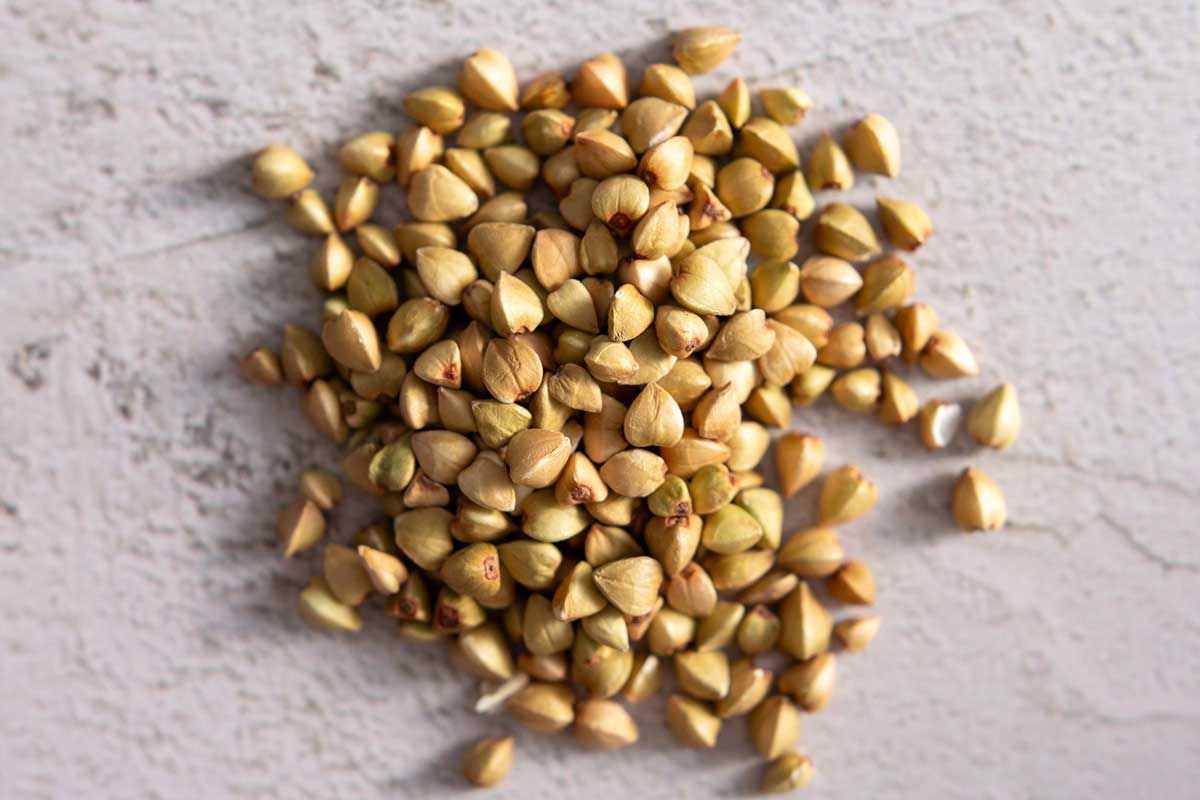
- Buckwheat is highly nutritious, offering a source of fiber and essential minerals, especially magnesium. It’s also packed with antioxidants, particularly rutin, which supports blood vessel health. Despite its name, buckwheat is naturally gluten-free, making it suitable for those with gluten intolerance or celiac disease.
- Buckwheat’s low to medium glycemic index makes it a good choice for those managing blood sugar levels. Plus, its high fiber content aids in digestion.
- Like amaranth or quinoa, these whole grain groats can be cooked like rice or oats, making them a fantastic ingredient for various dishes. From traditional porridge and pilafs to modern salads and even as a rice substitute, buckwheat is incredibly adaptable. It’s also used in making buckwheat flour, a popular alternative for gluten-free baking. We use buckwheat flour to make these High-Protein Buckwheat Pancakes with Blueberry Syrup, and they’re so fluffy and delicious!
Step-by-Step Instructions
Rinse the hulled buckwheat kernels under cold water until clear. After rinsing, soak 17.5 oz (2.6 cups or 500g) of buckwheat in cold water in a large bowl, fully submerged, and cover with a clean cloth for 6 to 7 hours.
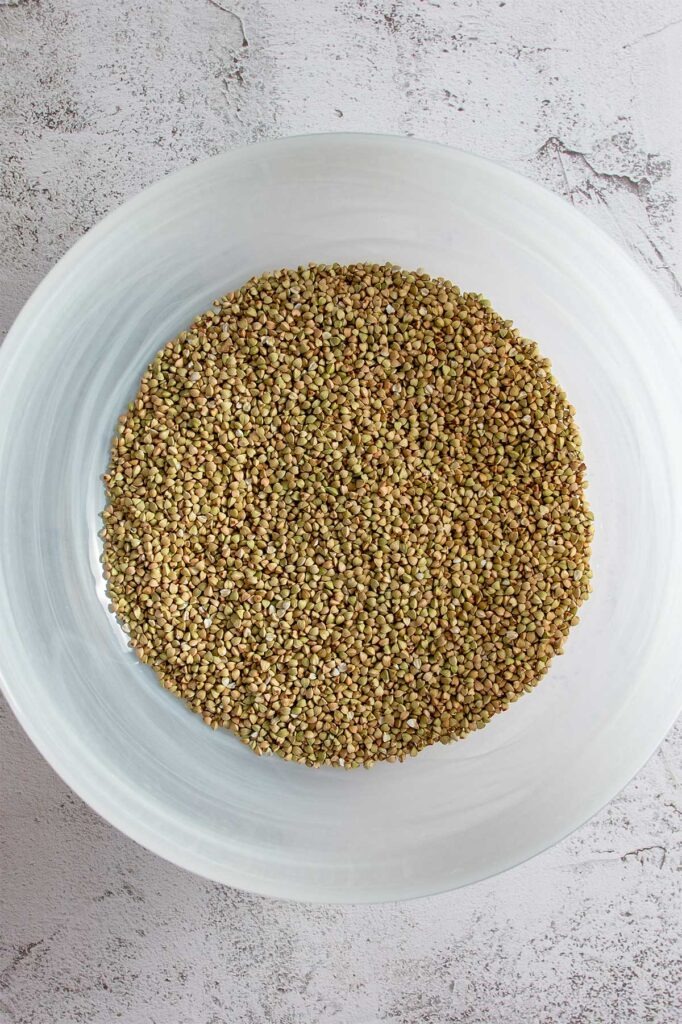

Once soaked, drain the remaining water, but do not rinse.


Transfer to a blender with 6.8 fl oz (0.9 cups or 200 ml) of water and ¼ tsp salt. Blend, starting at low speed and slowly increasing, until you get a very smooth texture without any pieces left. Pour the blended buckwheat mixture back into the bowl.
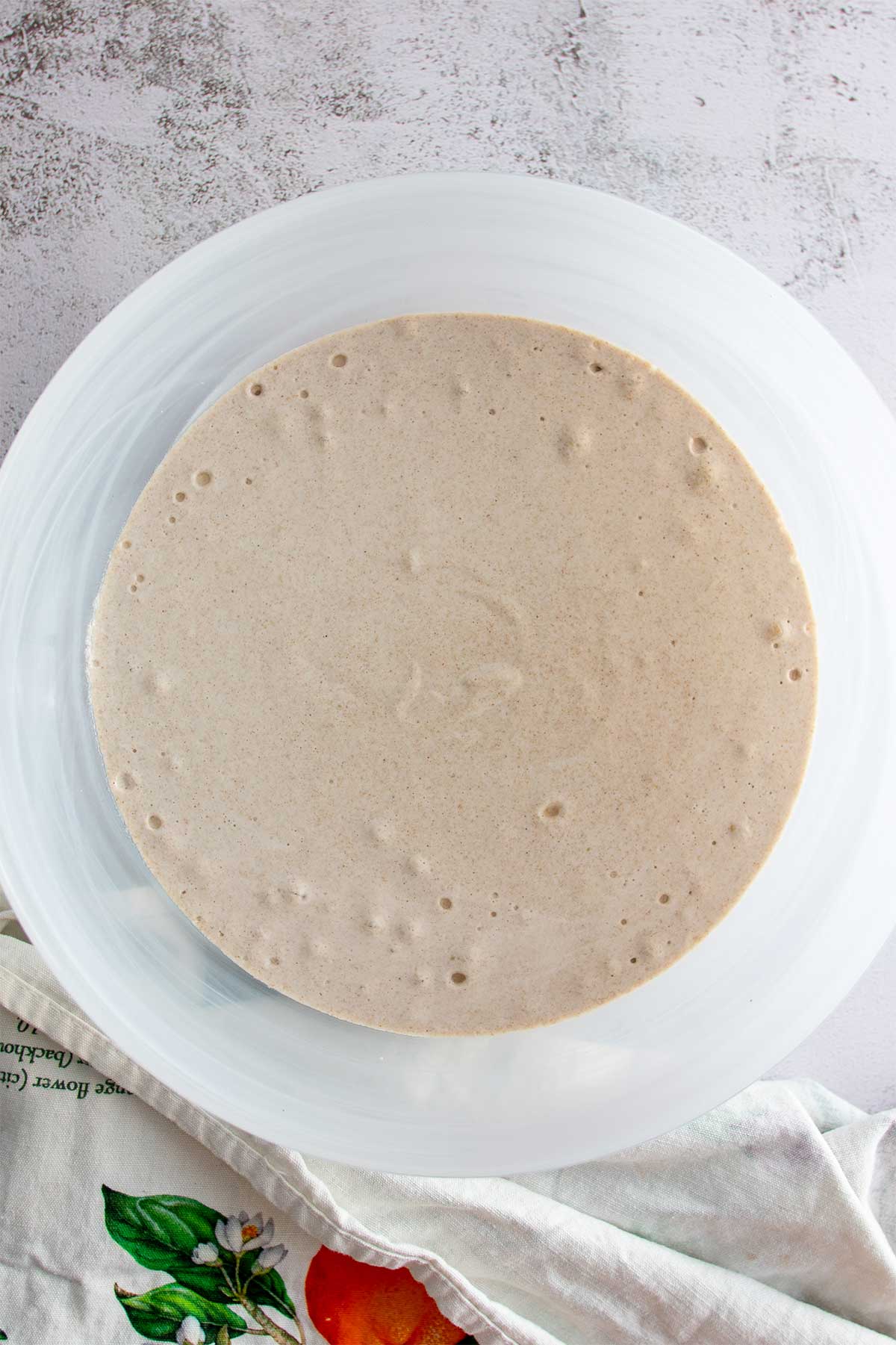
Cover it again and let it sit at room temperature for 12 to 24 hours to ferment. Please check the fermentation table below to confirm the time required based on your current climate.
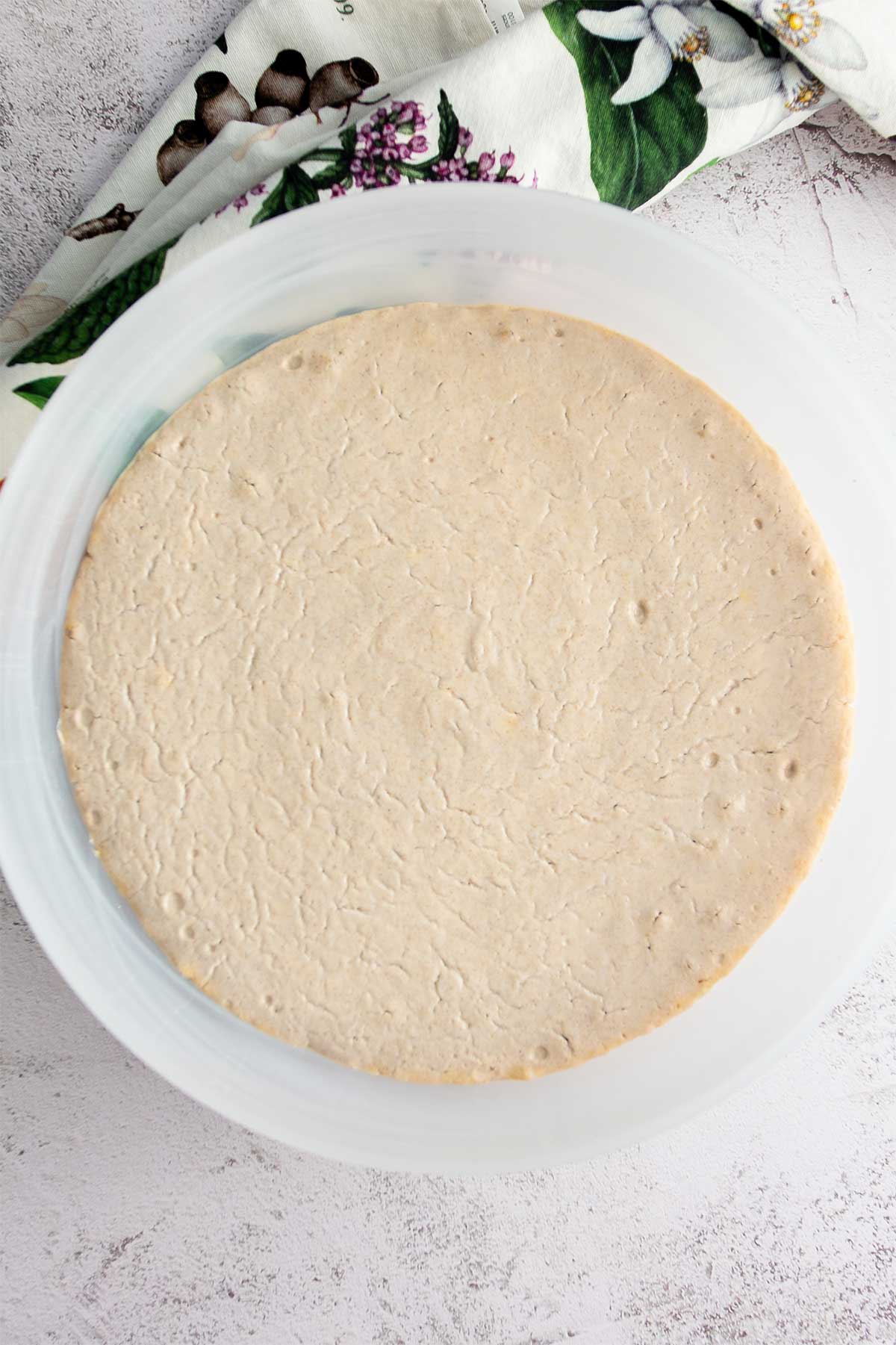

When you’re ready to bake, preheat your oven to 350°F. Line a loaf pan with baking paper and pour the fermented buckwheat dough into the pan. If you’d like, sprinkle the top with 2 tsp of poppy and sesame seeds (or whichever toppings you’d like).


Bake the bread in the preheated oven for 90 minutes. The bread should be golden brown and firm to the touch.


Allow the bread to cool down before slicing. This makes it easier to cut and improves the texture. Enjoy your homemade, nourishing, gluten-free buckwheat bread!


How Long to Ferment Your Buckwheat Bread Based on Your Current Climate
🌨️ Colder (Winter)
Indoor temperature range: ~70°F (20°C)
Soak: 6–7 hours
Fermentation time: Up to 24 hours
Note: If the temperature is lower than 70°F (20°C), place the bread in a warm spot or near a gentle heat source to help it ferment.
☀️ Warm (Summer)
Indoor temperature range: 75–85°F (25–30°C)
Soak: 6–7 hours
Fermentation time: Around 12 hours
Note: A warm environment speeds up fermentation, so check the texture after 10–12 hours.
🔥 Very Hot
Indoor temperature range: Above 85°F (30°C)
Soak: 6 hours
Fermentation time: As little as 6 hours
Note: The hotter it is, the less time needed. In extreme heat, soak the buckwheat in the fridge for 6 hours only.

1-Ingredient Buckwheat Bread (Nourishing and GF)
Equipment
Ingredients
- 17.6 oz (500 g) hulled buckwheat kernels (2.6 cups) - MUST be hulled, raw buckwheat kernels/groats for this recipe to work
- 6.8 fl oz (200 ml) water (0.9 cups)
- ¼ tsp (1.5 g) sea salt flakes
- 2 tsp (4 g) poppy and sesame seeds - optional
Instructions
- Rinse the hulled raw buckwheat kernels under cold water until the water runs clear. This ensures that any dust or impurities are removed.
- Transfer the rinsed buckwheat to a large bowl. Cover the kernels with a large volume of cold water, ensuring they are fully submerged. Cover the bowl with a clean cloth and let it sit for 6 to 7 hours.
- Once soaked, drain the water, but do not rinse the buckwheat kernels. Transfer them to a blender with 6.8 fl oz (0.9 cups/200 ml) water and the salt. Blend, starting at low speed and slowly increasing until you get a very smooth texture without any bits and pieces of buckwheat remaining.
- Pour the blended buckwheat batter back into the bowl. Cover it again and let it sit at room temperature for 12 to 24 hours (please see notes to determine how long you should leave it to ferment based on your climate). Once fermented, you will notice a very slight rise, and the mixture should be slightly bubbly inside.
- When you're ready to bake, preheat your oven to 350 °F. While the oven is heating, prepare a loaf pan by lining it with baking paper.
- Pour the fermented buckwheat dough into the prepared loaf pan. If using, sprinkle the top with poppy and sesame seeds.
- Bake the bread in the preheated oven for 90 minutes.
- Remove the bread from the loaf pan and let it cool completely before slicing. This is important to get the best texture. Now, enjoy your homemade, healthy buckwheat bread!
Video
FAQ
This depends on your location and current temperature, as fermentation is temperature-dependent. Colder climates will need a longer fermentation, and it can be shortened as the temperatures rise during the year, as the heat accelerates fermentation.
For colder climates (winter, with an indoor temperature of approximately 70°F (20°C)), ferment for 24 hours. If your indoor temperature is below 70°F (20°C), you can try leaving the batter in the warmest place in your house to give it the best chance of fermenting.
For warmer climates (summer with an indoor temperature between 75 – 85°F (25 – 30°C), I’d recommend starting with 12 hours of fermentation. We have tested this recipe in both summer and winter in Sydney Australia, which remains a pretty temperate climate. Depending on where you are in the world there might be a little bit of experimenting to figure out the perfect timing, but I promise it’s well worth it!
Some people from our IG community in more exotic locations with hotter and more humid climates have reported good results with as little as 6 hours of fermentation. If this is the case for you, start with 6 hours of fermentation and monitor the dough to avoid over-fermenting. The dough will have a slightly raised appearance and be a little bubbly inside when ready to eat.
Yes, fermentation does have a specific smell, which will be reduced when baking. Over soaking the buckwhat will result in a unpleasant smell, so keep it to 6-7 hours soaking time on the kitchen counter or in the fridge for extremely hot and humid climate.
Yes, it’s completely gluten-free.
This recipe only works with HULLED, NON-ROASTED buckwheat groats.
Unfortunately, it won’t work for this recipe.
It stays fresh for up to 3 days in a sealed container or wrapped in a kitchen cloth. I like to slice half straight away and freeze it to make the most of it.
Yes, slice and freeze for up to a month.
While the base recipe only requires one ingredient and cannot be swapped, you can certainly add other ingredients to customize the bread to your liking. Consider adding seeds, nuts, dried fruits such as dates, or spices for additional flavor and texture. I love a mix of black olives (pitted!), rosemary, and walnuts! Just remember to add these extras after the fermentation process and before baking. I however recommend tasting the bread without any ad-ons first, to make sure you have the perfect fermentation time, and know what to expect in terms of taste and consistency. Then, feel free to experiment with these additional ingredients to achieve your desired balance of flavor and texture.
You can; it will still work, but I find it provides a much-needed touch to the flavor of the bread.
It has a very slight rise – it’s quite different from yeast fermentation. Don’t worry if it looks like your dough hasn’t risen much – it will still work.
If that’s the case, I would recommend rinsing the buckwheat as it might develop a bit of a smell otherwise. It’s still fine to consume. We recommend not to rinse in our recipe, as when we tested it, we got a slightly nicer texture once baked, but it still worked when rinsed.
They are fine to leave on the counter. However, if it’s too hot or humid where you are, you can place them in the fridge. Leave out of the fridge for the fermentation part.
If you slice it before it cools down, it will just have a mushier texture.
If your indoor temperature is lower than the one we have mentioned, it might need to be fermented longer. Use filtered water if the water in your area contains a lot of chlorine, as this will negatively impact fermentation. Someone in the community also mentioned fermenting the dough directly in the loaf pan as a tip to get it to rise even more.


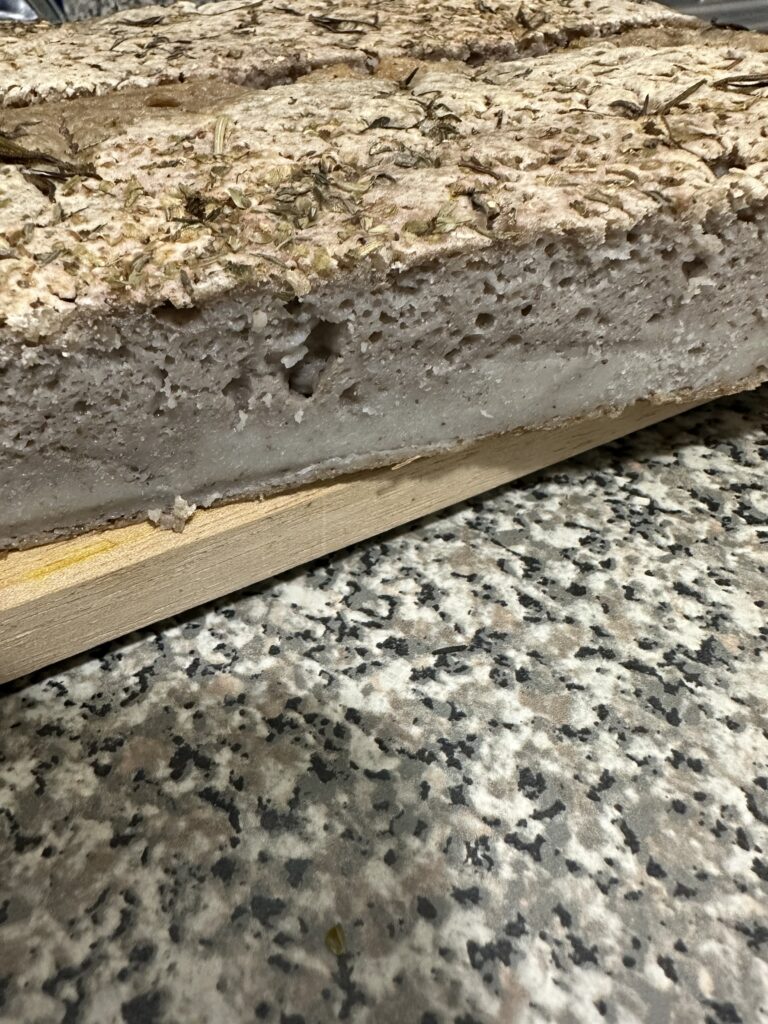
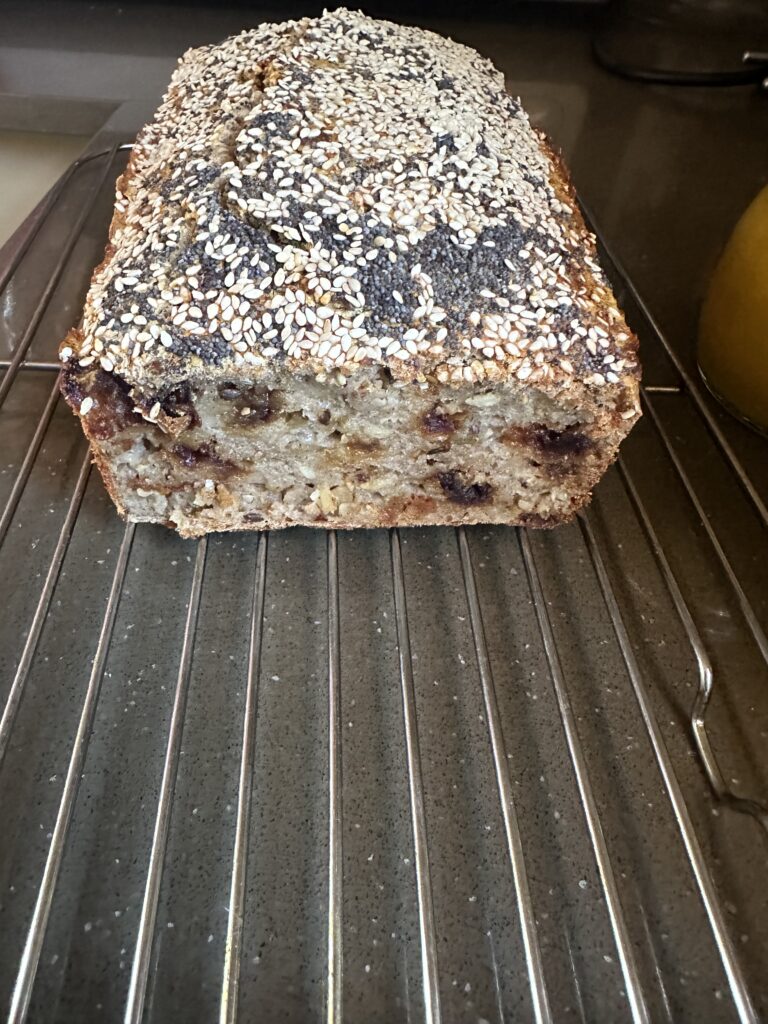








What temperature would you use for convection fan based ovens? Thank you
This is amazing as an alternative. Truly amazing. Jet my loaf did not rise. I’m in Italy and our house in the winter has about 15 degrees during the day. So for that reason I soaked it for 7 hours and then let it ferment for 40 hours and I let it sit for 1 hour in the warm oven before baking. It does not taste sour, which I would like and I think it needs more salt cause it’s described by my friends as “sweet”. I used spring mountain water. So next time I will let it ferment in the pan. I wonder if the none risen bread could be blended again and reused to ferment. It tastes good despite though.
My question: Should the temperature be higher from the start? Maybe add some yeast (yogurt, sourkraut juice…) to kick start it? Thank you
Hiya. Should I leave it in the tin to cool? Thanks
You can take it out 🙂
Came out great! What’s the best way to store the bread? Is it ok on the counter? Fridge? How long? Thank you!
So happy to hear that! I usually slice half straight away and freeze it, and keep the rest for up to 3 days in a sealed container, or wrapped in a kitchen cloth, on the counter.
Hi. Do I cover it during the fermentation please?
Yes cover with a clean cloth 🙂
Could you provide us with the measurements in grams ?
Kind regards,
Anna
Hey Anna,
You can select “metrics” measurements just above the ingredients list 🙂
The 2.6 cups I soaked overnight turned into a huge amount – 6 cups of buckwheat!
Is that ok?
Can I blend it with small amounts of the .9 Cups of water as I can’t fit this much into my blender?
Thank you
Hey Maureen, that sounds about right as it pretty much double in size. Maybe you could blend it in two batches?
Hi. I made the bread for the first time but could only get activated buckwheat. It has a very strong underlying taste. Is that the fermentation? How do you know if you have fermented it for long enough?
Hey Frances, I’ve never tried with activated buckwheat. Did you get a good texture? I’m surprised to hear it worked! Buckwheat does have a specific taste, and fermentation makes it a little more sour, I personally love it, but it’s quite different from wheat bread.
Turned out perfectly! Soaked for 7 hours. Fermented overnight and into early afternoon, Sydney. Moist, not too dense. My non inflammatory, plant based, gluten free, no oil, affordable!! go to bread recipe.
So happy to hear that! Thank you for sharing 💚
Can you please share the brand of buckwheat that you’re using? Thank you!
I usually get the 5 kilos bag from Honest to Goodness 🙂
Hi Erika, Chef’s Choice Organic Buckwheat Kernals 500g. If you are in Aus, Harris Farms stocks this brand.
mine came out like a gummy bear. do you think it’s because i fermented it too long or didn’t add the exact amount of salt? i so want this to work! looking forward to victory ha
Oh no 🥲 I’m not sure what you mean by gummy bear? If it’s still mushy / uncooked it might be because the wrong kind of buckwheat was used, it only works with hulled non roasted
What would happen if you use toasted buckwheat groats? I have a bunch in the cupboard I’d like to use up.
It won’t work unfortunately, and result in a mushy / uncooked bread 🥲
Wondering if I am already using sprouted buckwheat if I should soak it for the seven hours. Any thoughts?
I have not cooked with sprouted buckwheat before, so unsure, but hopefully someone else has an input 🙂
Yum! I’ve tried it, any tips on helping it rise a bit more mine came out quite flat
How long did you let it ferment? Maybe you could go a little longer? Tips we’ve gathered from the community in that case is to use filtered water, and letting it ferment directly in the pan before baking. Hope this helps, let me know how you go x
At step 4 with the instructions, what am I looking for, to tell me the fermentation process is complete? Bubbles? a particular smell? It’s not a very moist batter/mixture so I’m struggling to understand what it will be?
you mention covering it.. will a loose towel do; or should I be using a plastic saran wrap to seal it tightly?
A towel is fine 🙂 There is a slight rise but not much other cues, you can see the consistency on the video. Hope this helps 🙂
Hello! I am planning to make this recipe, but I could not find the quantities in grams (I will use a scale). How many grams of buckwheat and ml of water are needed? Thank you! 🙏
It’s 500g buckwheat and 200ml water, if you check just above the ingredient list for all our recipes, you will be able to select “metric” to get the ingredients in grams 🙂 hope you love it!
Thank you! 🥰🙏
My dough is quite stinky fermented for 24 hrs
Can i still bake and eat?
There is a slight smell, which will go down in the oven, however it should not be strong
Is it okay to ket the buckwheat soak longer than 7 hours? I just realized I won’t be home to rinse and blend them. Already started soaking. thanks
How did you go? It should be fine if you’ve left it a bit longer, especially if it’s not too hot where you are. but leaving it too long might lead to an unpleasant smell.
Excited to try this recipe so thanks for sharing. Can I add nuts, seeds, dried fruit or will this ruin the dough?
Yes you can add some just before baking, I would recommend to make the first loaf without to get more familiar with the recipe and then customise it 🙂
What do you think of using whey from homemade yogurt instead of water? I feel like it would help the fermentation and give it more of a sourdough feel… Thoughts…?
Sorry I’ve never cooked with whey so not sure!
Hi, I’m in the UK and keen to try this recipe. What are the quantities please ? I’m a bit confused by the US cups.
Many thanks
It’s 500g buckwheat and 200ml water, if you check just above the ingredient list for all our recipes, you will be able to select “metric” to get the ingredients in grams 🙂 hope you love it!